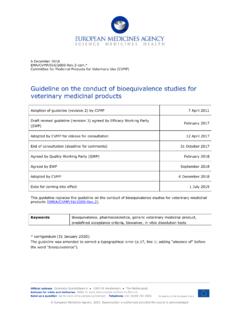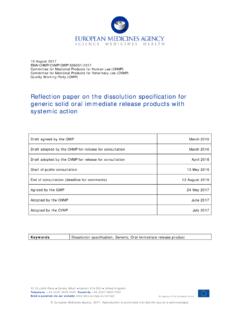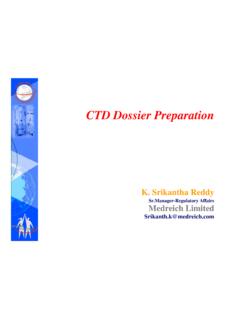Transcription of PROPOSAL TO WAIVE IN VIVO BIOEQUIVALENCE …
1 Working document page 1 WORLD HEALTH ORGANIZATION ORGANISATION MONDIALE DE LA SANTE PROPOSAL TO WAIVE IN VIVO BIOEQUIVALENCE REQUIREMENTS FOR THE WHO MODEL LIST OF ESSENTIAL MEDICINES IMMEDIATE RELEASE, SOLID ORAL DOSAGE FORMS World Health Organization 2005 All rights reserved. This draft is intended for a restricted audience only, the individuals and organizations having received this draft. The draft may not be reviewed, abstracted, quoted, reproduced, transmitted, distributed, translated or adapted, in part or in whole, in any form or by any means outside these individuals and organizations (including the organizations concerned staff and member organizations) without the permission of WHO.
2 The draft should not be displayed on any website. Please send any request for permission to: Dr Sabine Kopp, Quality Assurance & Safety: Medicines (QSM), Department of Medicines Policy and Standards (PSM), World Health Organization, CH-1211 Geneva 27, Switzerland. Fax: (41-22) 791 4730; e-mails: The designations employed and the presentation of the material in this draft do not imply the expression of any opinion whatsoever on the part of the World Health Organization concerning the legal status of any country, territory, city or area or of its authorities, or concerning the delimitation of its frontiers or boundaries.
3 Dotted lines on maps represent approximate border lines for which there may not yet be full agreement. The mention of specific companies or of certain manufacturers products does not imply that they are endorsed or recommended by the World Health Organization in preference to others of a similar nature that are not mentioned. Errors and omissions excepted, the names of proprietary products are distinguished by initial capital letters. The World Health Organization does not warrant that the information contained in this draft is complete and correct and shall not be liable for any damages incurred as a result of its use.
4 This document has been revised by Professor Jennifer B. Dressman, Institut f r Pharmazeutische Technologie, Biozentrum, Johann Wolfgang Goethe-Universit t, Frankfurt/Main, Germany. It has followed the steps given in the schedule on page 2 herein. It has been very widely distributed and numerous comments have been incorporated. Please address any comments and/or corrections you may have to Dr S. Kopp, Quality Assurance and Safety: Medicines, Medicines Policy and Standards, World Health Organization, 1211 Geneva 27, Switzerland, fax: (+41 22) 791 4730 or e-mail: (with a copy to by 20 October 2005.)
5 Working document page 2 SCHEDULE FOR THE ADOPTION PROCESS OF DOCUMENT : PROPOSAL to WAIVE in vivo BIOEQUIVALENCE requirements for the WHO Model List of Essential Medicines immediate release, solid oral dosage forms Deadline Consolidation of first list for consideration of biowaiver October 2004 Consolidation of comments March 2005 Discussion during consultation July 2005 Additional studies and review August-September 2005 Mailing of revised version for comments September 2005
6 Presentation to Fortieth WHO Expert Committee on Specifications for Pharmaceutical Preparations 24-28 October 2005 Working document page 3 PROPOSAL to WAIVE in vivo BIOEQUIVALENCE requirements for WHO Model List of Essential Medicines immediate release, solid oral dosage forms ABBREVIATIONS USED API Active Pharmaceutical Ingredient BE BIOEQUIVALENCE BCS Classification System Biowaiver Approval of a generic oral solid formulation of an API based on strictly defined dissolution criteria as a surrogate for an in vivo BIOEQUIVALENCE test (provided other aspects of the dossier)
7 Are deemed acceptable according to the usual criteria). EML WHO Model List of Essential Medicines HHS-FDA Department of Human Health: Federal Drug Agency, the United States of America Multisource document WHO working document entitled "Revision of multi-source (generic) pharmaceutical products: guidelines on registration requirements to establish interchangeability" SUPAC Scale-up and post-approval changes INTRODUCTION This PROPOSAL is closely linked to the working document , entitled Revision of multi-source (generic) pharmaceutical products: guidelines on registration requirements to establish interchangeability ("Multisource document").
8 It aims to give national authorities sufficient background information on the various orally applied APIs on the WHO Model List of Essential Medicines (EML) to enable them to make an informed decision, also taking into account Working document page 4 local usage of the API, as to whether generic formulations should be subjected to in vivo BIOEQUIVALENCE (BE) studies or whether a Biowaiver can be applied. In light of scientific work and discussion in the last decade, some of the criteria used to evaluate the API in terms of potential for a Biowaiver have been revised to allow a broadened scope of application.
9 The result is that many APIs on the EML can now be considered for the Biowaiver procedure, subject to the usage and risks in the national setting. BACKGROUND: HHS-FDA INITIATIVES TO ALLOW BIOWAIVERS BASED ON THE BCS In 1995 the American HHS-FDA instigated the Biopharmaceutics Classification System (BCS), with the aim of granting so-called Biowaivers for SUPAC changes ( ). A Biowaiver means that in vivo bioavailability and/or BIOEQUIVALENCE studies may be waived (not considered necessary for product approval).
10 Instead of conducting expensive and time consuming in vivo studies , a dissolution test could be adopted as the surrogate basis for the decision as to whether the two pharmaceutical products are equivalent. At that time the Biowaiver was only considered for scale-up and post approval changes (SUPAC) to pharmaceutical products. More recently, the application of the Biowaiver concept has been extended to approval of certain orally administered generic products ( ). Within the context of the documents cited above, only APIs with high solubility and high permeability and which are formulated in solid, immediate release (IR) oral formulations can be approved on the basis of the Biowaiver procedure.













